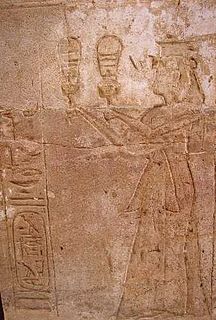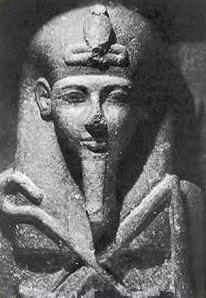Related Research Articles

In early Egyptian mythology, Anhur was a god of war who was worshipped in the Egyptian area of Abydos, and particularly in Thinis. Myths told that he had brought his wife, Mehit, who was his female counterpart, from Nubia, and his name reflects this—it means (one who) leads back the distant one.

The Fitzwilliam Museum is the art and antiquities museum of the University of Cambridge. It is located on Trumpington Street opposite Fitzwilliam Street in central Cambridge. It was founded in 1816 under the will of Richard FitzWilliam, 7th Viscount FitzWilliam (1745–1816), and comprises one of the best collections of antiquities and modern art in western Europe. With over half a million objects and artworks in its collections, the displays in the Museum explore world history and art from antiquity to the present. The treasures of the museum include artworks by Monet, Picasso, Rubens, Vincent van Gogh, Rembrandt, Cézanne, Van Dyck, and Canaletto, as well as a winged bas-relief from Nimrud. Admission to the public is always free.

Seti II was the fifth pharaoh of the Nineteenth Dynasty of Egypt and reigned from c. 1203 BC to 1197 BC. His throne name, Userkheperure Setepenre, means "Powerful are the manifestations of Re, the chosen one of Re." He was the son of Merneptah and Isetnofret II and sat on the throne during a period known for dynastic intrigue and short reigns, and his rule was no different. Seti II had to deal with many serious plots, most significantly the accession of a rival king named Amenmesse, possibly a half brother, who seized control over Thebes and Nubia in Upper Egypt during his second to fourth regnal years.

Merneptah or Merenptah was the fourth pharaoh of the Nineteenth Dynasty of Ancient Egypt. He ruled Egypt for almost ten years, from late July or early August 1213 BC until his death on May 2, 1203 BC, according to contemporary historical records. He was the thirteenth son of Ramesses II, only coming to power because all his older brothers had died, including his full brother Khaemwaset or Khaemwase. By the time he ascended to the throne, he was probably around seventy years old. He is perhaps best known for his victory stele, featuring the first known mention of the name Israel. His throne name was Ba-en-re Mery-netjeru, which means "The Soul of Ra, Beloved of the Gods".

Twosret, also spelled Tawosret or Tausret was the last known ruler and the final pharaoh of the Nineteenth Dynasty of Egypt.

Akhenre Setepenre Siptah or Merenptah Siptah was the penultimate ruler of the Nineteenth Dynasty of Egypt. His father's identity is currently unknown. Both Seti II and Amenmesse have been suggested although the fact that Siptah later changed his royal name or nomen to Merneptah Siptah after his Year 2 suggests rather that his father was Merneptah. If correct, this would make Siptah and Seti II half-brothers since both of them were sons of Merneptah.

Isetnofret was one of the Great Royal Wives of Pharaoh Ramesses II and was the mother of his heir, Merneptah. She was one of the most prominent of the royal wives, along with Nefertari, and was the chief queen after Nefertari's death.
Tiaa or Tiya or Tiy was thought to be the third wife of Pharaoh Seti II, after Takhat and Twosret. Fragments of her burial equipment were found in the tomb of Siptah (KV47), leading to the impression that she might have lived at the end of the 19th Dynasty. However, the king's tomb is connected to the burial of the 18th Dynasty queen Tiaa. The burial equipment of Tiaa mixed into the burial of Siptah. Recent research showed that all artifacts of a queen Tiaa belong to the 18th Dynasty queen. She is thought by some to have been Syrian (Ḫurru). She was once thought to be the mother of Rameses-Siptah, the next Pharaoh of Egypt after the death of his predecessor Seti II. However, Siptah's mother is now known to be a Canaanite woman named Sutailja or Shoteraja from a newly discovered relief in the Louvre museum.

Takhat was an ancient Egyptian princess and queen of the 19th Dynasty, the mother of the usurper pharaoh Amenmesse.
Amun was a major ancient Egyptian deity who appears as a member of the Hermopolitan Ogdoad. Amun was attested from the Old Kingdom together with his wife Amunet. With the 11th Dynasty, Amun rose to the position of patron deity of Thebes by replacing Montu.
Merenptah was an ancient Egyptian prince during the 19th Dynasty, likely to have been a son of Pharaoh Merenptah.
Senbuy was High Priest of Ptah in Memphis during the late Middle Kingdom of Egypt . Senbuy is known from a stela now in the Fitzwilliam Museum in England. Senbuy is depicted with his wife, the king's ornament Nubemheb, and their son Re-Seth. Senbuy's titles on the stela are given as hereditary prince and count, one whose coming to the temple is awaited on the day of the rising of Sothis, the greatest of the directors of craftsmen of the Lord of All, chief priest of his god, the lector-priest.

Isetnofret was a royal woman of Ancient Egypt and, as the Great Royal Wife of Pharaoh Merenptah, she became Isetnofret II.

Merysekhmet, also written Merysakhmet(mrỉỉ-sḫm.t; "Beloved of Sekhmet") was a vizier of Ancient Egypt. He served during the reign of Merenptah.

The Merneptah Stele – also known as the Israel Stele or the Victory Stele of Merneptah – is an inscription by the ancient Egyptian Pharaoh Merneptah, who reigned 1213–1203 BCE. Discovered by Flinders Petrie in 1896 at Thebes, it is now housed in the Egyptian Museum in Cairo.

Mentuemhat or Montuemhat was a rich and powerful Theban official from ancient Egypt who lived during the Twenty-fifth Dynasty of Egypt and Twenty-sixth Dynasty of Egypt. He was the Fourth Priest of Amun in Thebes.
The Theban Tomb TT385 is located in Sheikh Abd el-Qurna, part of the Theban Necropolis, on the west bank of the Nile, opposite Luxor. It is the burial place of the ancient Egyptian Hunefer (Haunefer), who was a Mayor of the Southern City (Thebes) during the reign of Ramesses II in the Nineteenth Dynasty.
Paser was an ancient Egyptian official under the king Ramses III in the 20th Dynasty. He was mayor of Thebes. His wife was a woman called Tity.
Anhurmose was an ancient Egyptian official of the New Kingdom. He was the high priest of Anhur under Merenptah, but started his career as a military man, most likely under king Ramesses II.
References
- ↑ Wolfgang Helck: Zur Verwaltung des Mittleren und Neuen Reichs (= Probleme der Ägyptologie. Band 3). Brill, Leiden 1958, pp. 425, 528.
- ↑ E. A. Wallis Budge: Catalogue of the Egyptian Collection in the Fitzwilliam Museum, Cambridge 1893, pp. 4-7 online